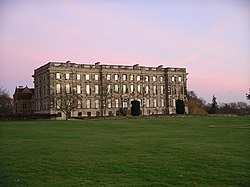Stoneleigh Abbey
| Stoneleigh Cistercian Abbey | |
|---|---|
 The existing house on the site of the abbey |
|
| location |
|
| Coordinates: | 52 ° 20 '18.4 " N , 1 ° 31' 53.6" W |
| Serial number according to Janauschek |
350 |
| Patronage | St. Mary |
| founding year | 1155 |
| Year of dissolution / annulment |
1536 |
| Mother monastery | Bordesley Abbey |
| Primary Abbey | Citeaux monastery |
|
Daughter monasteries |
no |
Stoneleigh Abbey (Stanleia) is a former Cistercian abbey about 1.5 km southwest of Stoneleigh between Coventry and Warwick in Warwickshire in England , near the River Avon and its tributary Sow.
history
The monastery was re-established in 1155 after a previous foundation by King Stephen and Mathilda of Boulogne between 1138 and 1147 in Redmore in Staffordshire by King Henry II in Stoneleigh. It was a daughter monastery of Bordesley Abbey and thus belonged to the filiation of Cîteaux . The first buildings came from the founding time and corresponded to the Bernhardin plan. In 1241 the monastery suffered severe fire damage. The church was probably not rebuilt later, but the east wing was rebuilt around 1300. In 1321 there was a robbery by the Earl of Hereford. After the abbey, which was never particularly prosperous, was dissolved (the annual income in the Valor Ecclesiasticus was estimated at 151 pounds in 1535), the monastery was handed over to the Duke of Suffolk, but his family soon went out, and the buildings came to the London merchant Sir Rowland in 1562 Hill and to Sir Thomas Leigh, with whose family they remained until 1996. Today the plant houses the National Agricultural Center.
Buildings and plant
The monastery was converted into a manor house, which includes the cloister garden as an inner courtyard and with its east wing encloses the south transept of the church and the east wing of the abbey. The north wing of the house takes the place of the south aisle of the church and preserves parts of it, but was rebuilt around 1830. A large baroque wing was built on the west wing by Francis Smith of Warwick from 1714 to 1726. The south wing is a collection of building parts from the 18th and 19th centuries. The gatehouse and the inn have been preserved from the medieval complex in a converted state. In 1960 the west wing was damaged by fire.
literature
- Anthony New: A guide to the Abbeys of England and Wales. Constable & Company, London 1985, ISBN 0-09-463520-X , pp. 360-362.